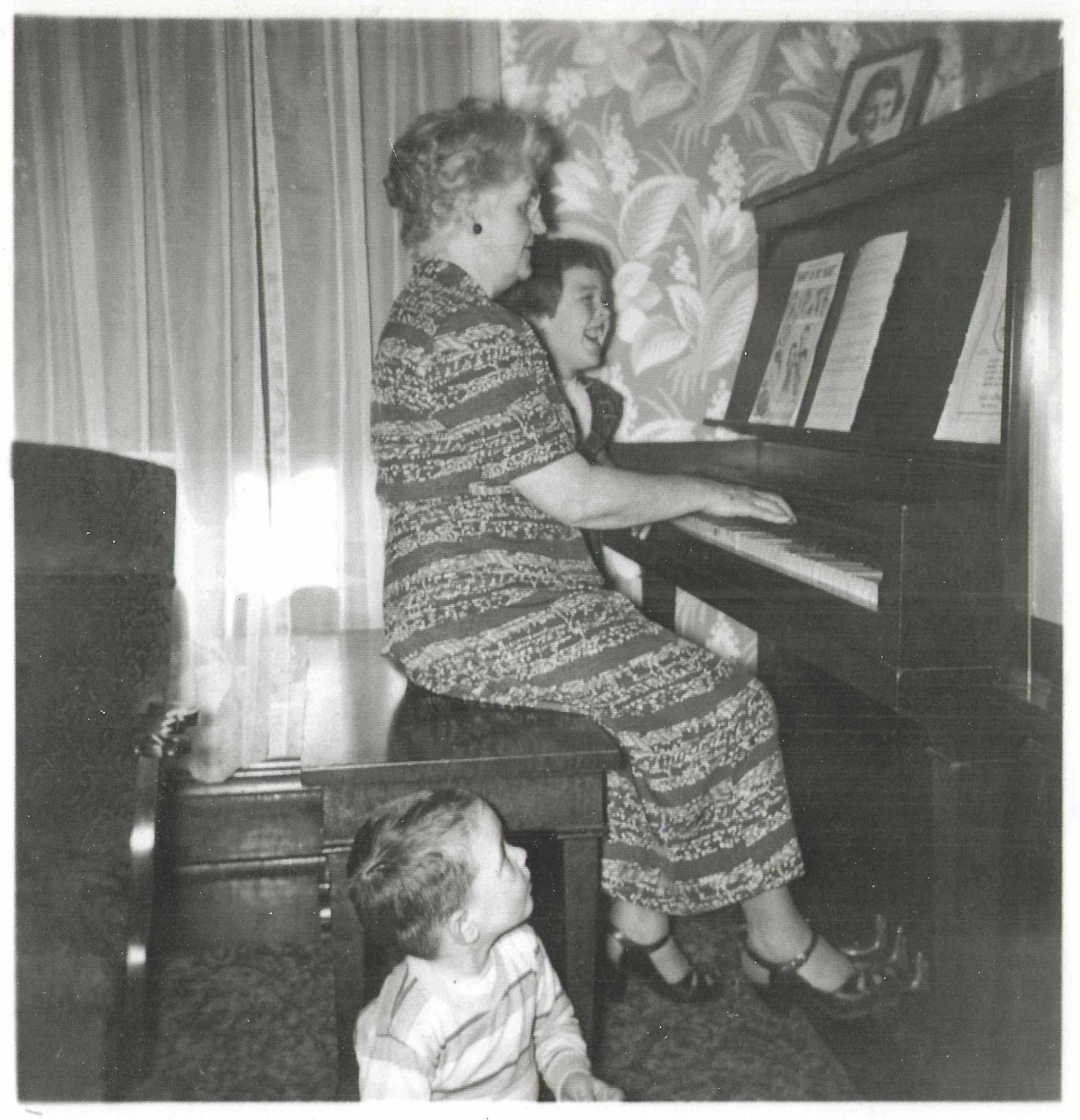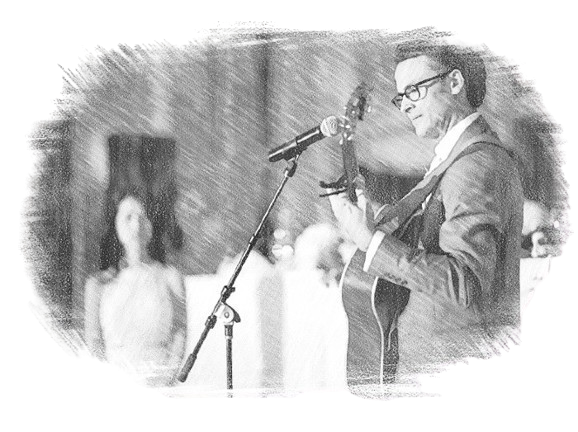 The love of music passed from generation to generation: Mom sitting with her Grandma Kate.
The love of music passed from generation to generation: Mom sitting with her Grandma Kate.“[Great music]1 invigorates our best faculties and…inspires love in the highest part of the soul.” (—Iris Murdoch)
⚠ Achtung: this is more journaling than incisive essay, so it might bore you to death, Dear Reader, assuming you’re not my wife or my mother
 The love of music passed from generation to generation: Mom sitting with her Grandma Kate.
The love of music passed from generation to generation: Mom sitting with her Grandma Kate.
Music’s in my soul by nature and nurture, thanks firstly to my mother. Mom took up piano at a young age, but discovered she both loved it and had exceptional talent early on: playing all the weddings and funerals at her church by the fourth grade, did college on a full ride music scholarship, joined the USO Tour, and the list goes on. Instead of being a professional musician on the Lawrence Welk Show—she turned down the job offer—she married my dad and taught music to grade school students and also played at our church, St. Cecilia’s, patroness of music. So live piano music was a fixture in our home, and I grew up singin’ in church just one pew behind Mom because participating in sung worship wasn’t exactly optional2. I also started my own piano lessons in kindergarten, but Mom’s policy was if you weren’t demonstrating your own motivation to practice by sixth grade, she wasn’t going to force it and would let us opt out. And so I regrettably quit near that first opportunity.3
Then in the summer between my freshman and sophomore years of high school, my family was in northern Wisconsin on vacation and Mom was strumming an old nylon string guitar that just appeared out of nowhere. “Mom, I didn’t know you played guitar,” I said incredulously. She explained how she had to demonstrate proficiency in three instruments for the USO Tour, so guitar ended up being one of the three, but, she said, “I really only know a few chords… Come here; this song’s easy…” And she proceeded to show me the ‘D’, ‘A7’, and ‘G’ chords for the tune she was playing, Blowin’ in the Wind. Once I got those first few chords down she said, “now I do have a rule that if you’re going to play guitar, you need to sing, too.” I had to concede the singing because I was hooked on the guitar. Mom had a book of songs from the Old Town School of Music and I went through nearly every song, forcing my fingers to make shapes they decidedly did not want to make, pushing through the fingertip pain until I had callouses, and belting folk melodies that Mom would occasionally harmonize to. I played that nylon string guitar constantly until a Christmas gift arrived: an arch-backed, rosewood-necked Gibson gospel-style acoustic; an exquisite instrument I hadn’t yet earned through skill, but one that motivated me even more.
I wasn’t a remarkable singer but I was in fact singing at a time when most of my peers were not, because, hey, puberty makes it tricky for a while there for us boys. So I decided I’d get up on stage and perform at my high school talent show. Bob Marley’s Redemption Song, accompanied by percussion phenom Dan Capecchi on cajón. I’m not sure how well it went, but I liked something about being in front of an audience and fighting through the intense butterflies. And so, I auditioned for the spring musical (Working by Studs Terkel) and landed a singing part…another test of the taming of the butterflies. And then rock bands, beginning in high school with the cover band Obscurity that certainly lived up to its name.
Come college I had had enough time singing and playing and performing in front of people that I could muster the courage to audition for the Heightsmen of Boston College, BC’s all-male a cappella group, which would end up being a defining part of college. A cappella improved my vocals in the same way the Beatles improved: through sheer volume of rehearsals and performances and recording sessions. But it also enabled and exacerbated my music illiteracy by its model: instead of reading sheet music, our “music director” peer who had arranged a given song in four-part harmony would teach each section (e.g., baritones) their part by ear, echoing the piano after it plucked out the sequence note by note. Why? Because three-quarters of us were at best iffy on music theory, let alone sight-reading.
It wasn’t all singing in college; lots of guitar, too: formally with the Liturgical Arts Group (Masses), but also countless dorm room jams. I went from chord charts to tabs. (For the uninitiated, “tablature” is a poor man’s musical notation that maps fingering [fret x string] rather than the actual notes on a traditional scale.) For the music theory challenged such as I, tabs were a big unlock—suddenly those 50 songs in my chord-based Old Town School of Music songbook gave way to thousands available on the On-Line Guitar Archive (OLGA). It was really in fumbling through these tabs, and not through any formal instruction, that I ended up teaching myself guitar4—my constructivist learning tendency on display. I even contributed my own tabs—e.g., this Ben Harper song during freshman year of college, which is still discoverable on the interwebs:
e|--------------------------------| B|--0h1---1------0--0----0h1p0----| G|--0-----2------0--0---2-----2---| D|--2-----3------------2-------2--| A|--------------------------------| E|------------3-------------------|
Post-college I found a real void in my life that the Heightsmen once occupied—part musical, part social/fraternal. It wasn’t until my dear friend and silky-smooth-singing’ fellow Heightsman Michael McAndrew moved back up to Boston for law school that he and I joined forces with jazz wunderkind and prolific composer Paul Findlen to start a band with a “soul-rock” feel.
 Say Hey’s now-defunct world wide webpage that I engineered to withstand traffic surges in the hundreds of thousands.
Say Hey’s now-defunct world wide webpage that I engineered to withstand traffic surges in the hundreds of thousands.
We became great buds through those practices and performances and recording in the most stifling-yet-acoustically-perfect coat closet in all of Beacon Hill. Before we ever got signed to a major label, I left for business school in Ann Arbor. Yes, there was a b-school band and open mic nights and such, but the major creative outlet was a revue called Follies.
After moving to Chicago, I found myself in two contrasting musical worlds: one had me belting out screamy rock songs in a cover band on Thursday nights, while the other found me harmonizing beautiful, intricate sacred pieces in a church choir on Sunday mornings. Both had their place.
 Playing at some neon-lit, smoke-stained, sticky-floored hideaway.
Playing at some neon-lit, smoke-stained, sticky-floored hideaway.
In California, I filled the music need with various jam sessions: Patricia Ang’s “Musical Playgrounds”, Nolan Love’s “Harvest Parties”, St. Dom’s “Coffeehouses”, Priory East “hootenannies”5, etc.
But most importantly, I picked back up liturgical music ministry, joining the 5:30pm Contemporary Choir at St. Dominic’s Church. And it was in the basement rehearsal room that I first met Lisa Chung, who would three years later become my wife—the very best result of my haphazard music odyssey6.

— ᴘ. ᴍ. ʙ.
In actuality she said “great art” or “good art”, and so I’m taking some license with her quote. ↩
…@Dad…👀 ↩
Embarrassingly enough, my wife had just about the same number of years of piano and is competent enough to sight-read fairly complex music whereas I just know the chords to a few Springsteen and Dawes songs. ↩
There was/is a price to pay for skipping the actual guitar lessons, and that is my plateauing and never really learning my scales well enough to be able to “solo”…on the fly…in whatever key the jam is. ↩
Okay, I lied: no one called them “hootenannies”; just a little wistful fabrication there. ↩
A fitting outcome for someone whose “[P]erceiving” preference, as my MBTI-conversant family would say, tends toward spontaneity over rigid planning. ↩